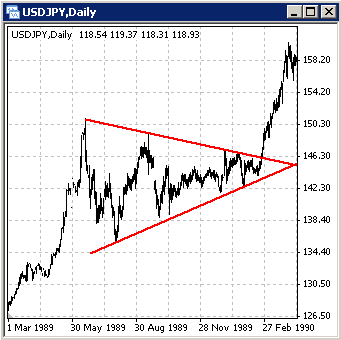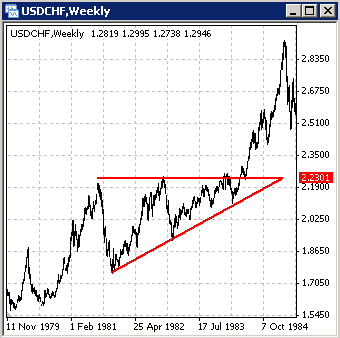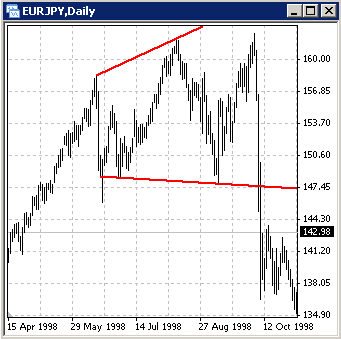Continuation Chart Patterns:
Triangles
Continuation patterns indicate that price sluggishness is only a pause in the prevailing trend, not a sign of a forthcoming reversal.
Continuation patterns typically take less time to form than reversal patterns.
Triangles are powerful continuation patterns:
TECHICAL ANALYSIS
_________________________________________________________
There are four different types of triangles:
- symmetrical,
- ascending,
- descending, and
- expanding.
Symmetrical triangle consists of two converging trend lines (upper line goes lower and lower line goes higher). The point at which they cross is called top:
Its upper trend line is horizontal whereas the lower one is upward sloping. This is a bullish formation as in this scenario buyers are more active than sellers. When an ascending triangle develops, it is usually a good chance for an upside breakout to occur.
Ascending triangles are usually formed as a continuation pattern in an uptrend, but sometimes they can be found at the bottom of a downtrend, signaling a reversal. Even if the market is bearish this chart pattern should be considered as bullish.
Descending triangle is a bearish formation, a mirror image of an ascending triangle:
How to analyze symmetrical, ascending and descending triangles:
Classic triangle has five lines (three downward and two upward or vice versa).
If the price penetrates the triangle downwards then the price may continue to fall.
If the price penetrates the triangle upwards the price may continue to rise.
If the pattern angle is up-directed the price may move higher.
If the pattern angle is down-directed the price may move lower.
If prices remain within the triangle beyond the three-quarter point, the triangle begins to lose its potency, and prices may continue to drift out to the apex and beyond.
The breakout usually occurs between ? and ?.
Triangle top will be the support/resistance level.
Typically, volume is heavy at the beginning and it contracts during the formation of a triangle. It increases again during the breakout.
The price continues moving in the direction of the breakout for at least a range equal to the triangle's height.
An expanding triangle (more often appears at highs) consists of three gradually rising highs and two gradually falling bottoms:





When the downward price movement crosses the level of the second bottom, this means that the pattern formation is about to end, and that is a signal to open a Sell position. Once the signal has been given prices may pull back up half of the range they have moved downward. After this pull back, the bearish trend resumes. Although, as a rule, the third top is higher than the previous two tops, sometimes it may be at some level of the second one or even a little bit lower. In this case the pattern resembles the Head and Shoulders chart pattern with a downward Head Line.
There must be at least four reversal points in order for a triangle to be recognized, but there may be more (for example, six: three peaks and three troughs).
In most cases the breakout occurs in the middle to three-quarters of the triangle width. If within three-quarters of the triangle width the breakout has not occurred, the subsequent price action will be weak and difficut to predict. The fewer price fluctuations inside the triangle, the more chances that trading volume will decrease (this is a common rule for most continuation patterns).
The formation ends when a trend line is broken. It is sometimes followed by a pull back to the trend line (if it was an upside breakout then it would be the support level, if downside breakout it would be the resistance level). The top of the triangle will be the important support/resistance level. To estimate if the triangle line breakout is true, please refer to the methods previously used to test trend lines breakouts.
Ascending triangle is a type of symmetrical triangle:
----------- EDUCATION ---------
-------TRADING METHODS ------
--------- FOR TRADERS ----------
-------------- OTHER ------------

_________________________________________________________________________________________________________________________________________

